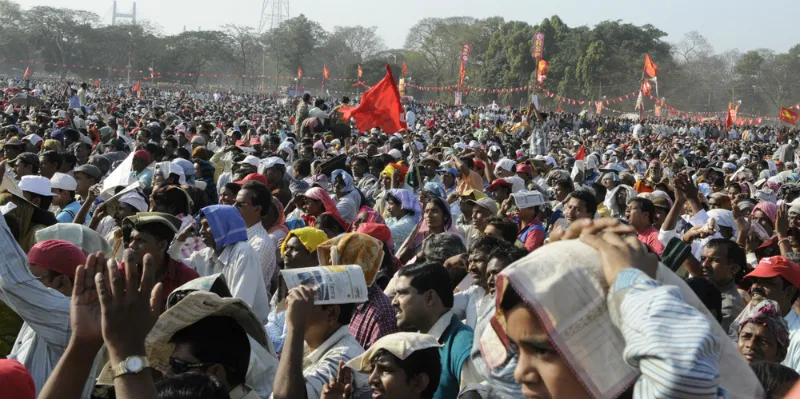General Elections 2019: Reflecting on India’s history and the way forward
Irrespective of the result of the election, I believe that India has a bright future ahead. India’s long-term story is one of stability compared to other emerging markets, writes Vani Kola.
Despite his failing vision and aching knees, 102-year-old Shyam Saran Negi, a retired school teacher, reached his voting booth in Himachal Pradesh’s Kinnaur district last Sunday to exercise his right to vote. Shyam holds the title of India’s ‘first-ever voter’ as he was the first person to cast his vote in India’s 1952 elections. With a glint in his eyes, he recently told the media that he has never missed casting his vote ever since then whether it was a Panchayat election or the Lok Sabha polls.

Land of a billion dreams: A large crowd at an election rally in Kolkata. (Image: Shutterstock)
While there are some who either cannot or decide not to exercise their right to vote during the election season for multiple reasons, it is always inspiring to hear about instances where even old age, physical impairments or social commitments (including one’s own marriage) don’t prevent people from casting their vote.
The world’s largest democratic exercise recently reached its conclusion when 67 percent of the 900 million eligible Indians exercised their right to vote. This was the highest ever turnout recorded in any parliamentary poll in the country.
Irrespective of the result of the election, I believe that India has a bright future ahead. India’s long-term story is one of stability compared to other emerging markets. Our economic growth has seen a steady CAGR of seven percent across 25 years, 20 years, 15 and 10 years, no matter which government has been in power. Recently at the Kalaari Summit 2019, Rashesh Shah, CEO of the Edelweiss Group noted,
“We have had over 20 years of political stability (four governments that have completed their terms). Our inflation at its lowest has been two percent and its highest at 10 percent. But we don’t appear to be stable. It is a paradox of sorts.”
India, a land of unity in diversity
India is known globally as a land rich in culture, history, contrast, and diversity. Where else would you see 8000 diverse candidates from 460 political parties competing for the 543 seats in the lower house of the Parliament or Lok Sabha?
The sheer logistics and coordination behind the scenes to ensure a smooth voting experience is remarkable. About one million voting booths are set up across the country in the different phases of the election. As per the Election Commission guidelines, no voter should have to travel more than two km to reach a polling station. Apart from vehicles, elephants, boats, and camels are deployed across India to ensure that even the remotest of locations are covered.
India currently represents 1/10th of humanity and the sheer scale and execution prowess involved in our democratic process serves as an inspiration to the entire world.
Today, India has a strong, diversified economy and is a world leader in various industries, notably Information Technology and is also considered the fourth most vibrant startup ecosystem globally with 13 of the world’s 326 unicorns based in the country.
The country’s current stance can be attributed to multiple internal and external factors. Shortly after independence in 1947, the Indian government adopted a series of five-year plans to modernise the largely agrarian economy into an industrial one. Among the developments was the formation of the Planning Commission — a key agency for economic planning for successive governments. Another key landmark was setting up of the Indian Constitution which laid the foundation and framework for India’s path forward.
The Indian Constitution
The Indian Constitution is the longest written constitution of any sovereign country in the world, containing 444 articles in 22 parts, 12 schedules, and 118 amendments, with 146,385 words.
Dr BR Ambedkar had studied the constitutions of about 60 countries and is credited for drafting the original Indian Constitution which had 395 articles in 22 parts and 8 schedules.
The original 1950 Constitution is preserved in a helium-filled case at the Parliament House in New Delhi and serves as a symbol for how the founding fathers of the nation envisioned the country’s future.
So far, the government has enacted a number of acts and laws, policies and rules keeping in view the Directive Principles, which are directly related to the business operations. The various Acts like Foreign Exchange Regulation Act (FERA), Factories Act, Monopolistic and Restrictive Trade Practice (MRTP) Act, Minimum Wages Act, Industrial policy, are based on the Directive Principles of the Constitution. Going forward too, the Constitution will play a key role in our democratic process.
India rising
India is one of the fastest growing economies in the world and is expected to be the second-largest economy by 2030, next only to China after overtaking the US.
India’s stock market has grown 70 percent in the last five years and an estimated 500 million Indians are connected to the internet. Indians have accomplished a lot globally and also hold a place of pride in the startup world.
Countries around the world look at India closely for the sheer opportunities and growth avenues that are being unlocked. Companies like Netflix and Amazon are pouring billions into generating Indian content. Apple, Ikea, and Xiaomi are also some of the companies that are part of the ‘Make in India’ wave looking to tap into the India opportunity.
Aging populations are likely to slow down global growth, but India, home to the world’s largest group of young people, will likely remain unfazed. Half of the country’s population is under the age of 25. But a young demographic also creates a demand for massive employment. About 100 million new jobs must be created in the manufacturing and service sectors by 2030. To achieve this, the Indian government needs to close a widening skills gap, raise the participation of women in the workforce, make India a more startup-friendly nation and also ease labor laws.
The rising aspirations of a young population continue to support consumerism in India’s economy. At the same time, Indians are also diligent savers, value conscious, and generally don’t accumulate debt. Given the dynamics, global companies like Uber look to use India as a test bed to develop deep consumer insights, make products, and then roll them out globally.
If you can succeed in India, then you can scale anywhere in the world.
Indian elections are watched closely by everyone around the world because of the potential impact it can have and also because of the unfathomable scale at which it is conducted. I, like everyone else, eagerly anticipate the results of the election.
As The New York Times put it, "The greatest show on Earth, an ode to a diverse & democratic ethos."
Acknowledging Harshith Mallya and Chirag Gandhi, who contributed to this article. Harshith and Chirag are Kstart Fellows.
(Disclaimer: The views and opinions expressed in this article are those of the author and do not necessarily reflect the views of YourStory.)







